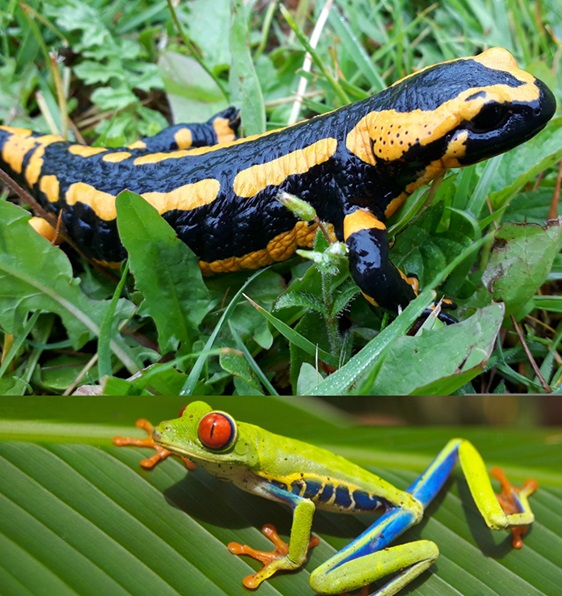
Amphibians, a class of vertebrates that includes frogs, toads, salamanders, and newts, represent one of the most unique and diverse groups of animals on the planet. Characterized by their dual life stages—larval (typically aquatic) and adult (often terrestrial);
Today, around 8,000 known species of amphibians inhabit a wide range of environments, from tropical rainforests and grasslands to deserts and temperate regions.
The class Amphibia is divided into three main orders:
Anura (frogs and toads): This is the largest order, known for the diversity of body shapes, sizes, and adaptations. Frogs typically have smooth, moist skin and long hind legs for jumping, while toads possess dry, bumpy skin and are generally more terrestrial.
Urodela(salamanders and newts): Salamanders are often recognized by their elongated bodies and tails, with many species exhibiting remarkable regenerative abilities. They typically lead a more secretive lifestyle, often found in moist habitats.
Gymnophiona (caecilians): These legless, worm-like amphibians are less well-known, primarily inhabiting tropical regions. They live underground or in leaf litter, showcasing a unique adaptation to a burrowing lifestyle.
Life Cycle And Reproduction
Amphibians undergo a fascinating life cycle that usually involves external fertilization. Most species begin their lives as eggs laid in water, which hatch into aquatic larvae. For example, tadpoles transform into adult frogs through a process called metamorphosis, during which they develop lungs, lose their tails, and grow limbs.
This dual life cycle is crucial not only for their survival but also for their ecological role. Larval stages often feed on algae and organic matter, contributing to nutrient cycling in aquatic ecosystems, while adults play vital roles in terrestrial environments as both predators and prey.
Ecological Importance
Amphibians serve as indicators of environmental health. Their permeable skin makes them highly susceptible to pollutants, temperature changes, and habitat destruction, which reflects the quality of both terrestrial and aquatic ecosystems. As predators of insects and other small invertebrates, they help to regulate populations within their habitats, thereby contributing to biodiversity and ecological balance.
Additionally, amphibians are a key food source for a variety of species, including birds, mammals, and reptiles. Their roles in food webs highlight the interconnectedness of species within ecosystems and underscore the importance of their conservation.
Threats To Amphibian Populations
Despite their ecological significance, amphibians face numerous threats that have led to alarming declines in populations worldwide. Habitat destruction, climate change, pollution, disease (particularly chytridiomycosis), and invasive species are the primary drivers of amphibian decline.
The Global Amphibian Assessment in 2004 revealed that approximately one-third of all known amphibian species are threatened with extinction. Conservation efforts are increasingly necessary to protect these remarkable creatures and their habitats. Initiatives range from habitat restoration and legal protection to captive breeding programs aimed at reintroducing threatened species.
Conservation Efforts
Organizations and researchers globally are working tirelessly to conserve amphibian species. Strategies include:
Habitat Protection: Establishing protected areas that encompass critical habitats for breeding and foraging.
Research And Monitoring: Conducting studies to better understand amphibian life cycles and populations helps inform conservation initiatives.
Public Awareness: Educating communities about the importance of amphibians fosters a sense of stewardship and encourages responsible behaviors toward the environment.
Disease Management: Researching treatments and developing strategies to combat the spread of pathogens affecting amphibian populations.
Conclusion
Amphibians are a testament to the adaptability of life on Earth. As both indicators of environmental health and integral components of ecosystems, their preservation is essential for maintaining biodiversity. Understanding and mitigating the threats they face is crucial not only for the survival of these fascinating creatures but also for the health of our planet. The challenge ahead is significant, yet through concerted efforts and increased awareness, there is hope for the future of amphibians and the ecosystems they support.
